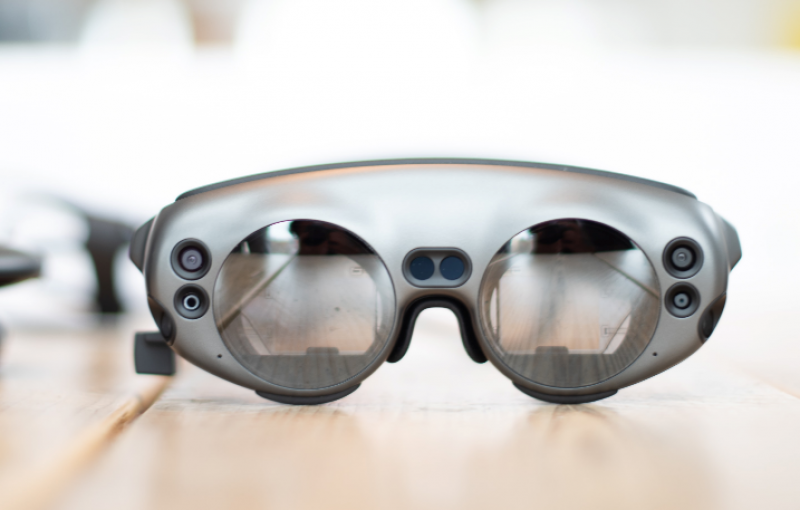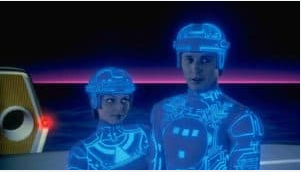
Can Virtual Reality Improve How Teachers Are Trained?
by Eoin Bastable June 17, 2021(Teacher walks to the front of a classroom.)
Teacher: Good morning everyone, let’s get started.
Student: This sucks!
Teacher: Excuse me? (grimacing, eyes narrowing)
Student: You heard me (student glares). This class sucks!
Teacher: Take your stuff and go to the office (pointing to the door).
Student: See, I knew you didn’t care about me!
Fade to black & cue music…
If you are an educator, you’ve probably seen video clips like this one in a training or workshop. In reality, capturing realistic student-teacher interactions is no easy task. More often than not, teachers don’t see themselves or their students in these scenarios.
“The students in the videos don’t match my experience.” “That’s not how I would have acted,” are comments I have heard from educators after a training or conference session.
Virtual reality (VR) companies believe they can enhance how training is delivered and experienced by educators. Shiftbias, based in Bend, Oregon, is designing digital environments where teachers experience virtual taunts, disruptions, and even ambulance sirens rushing by outside their classrooms. Equal Reality advertises an Experience Flow allowing teachers to “walk a mile in someone else’s shoes.” To those who deliver or attend educator professional development, sounds like a big step forward. But, can VR-based training deliver?
You are Tamara
In a promo video on Equal Reality’s website, an avatar called Sarah invites me to see the world as “Tamara” sees it. Tamara is a middle-aged, African American woman dressed in professional attire. As soft, hypnotic music plays in the background, I am asked to look at myself in a mirror. “You are now Tamara,” says Sarah, “take a moment, stretch your arms and get used to your new body.” Moments later, I am led to a generic workplace where co-workers approach me/Tamara with inclusive and non-inclusive language and gestures. Even though I do not have a set of VR goggles to access the full, multi-sensory experience, I wondered whether “being” Tamara for 20 minutes would shift how I interact with people who look or act like her in a real workplace.
In education, VR-based training is enabling teachers to temporarily adopt the perspectives of students from a range of socio-economic backgrounds, genders, or races. Educators can experience tantrums or eye-rolling “on-demand” from seven different angles. VR designers can also mimic what it is like to be stereotyped or subjected to derogatory slurs from a colleague or peer. Simulations are allowing teachers to explore their blind spots first-hand in an effort to raise awareness of implicit bias. These are just some of the benefits VR companies are promoting for educators and schools.
As virtual reality-based training gains steam in the gaming industry, corporate board rooms, and police academies1, is there evidence this technology can improve teacher professional development? Can cheeky nine-year-old avatars help improve my classroom management chops? Is VR a viable option for my school or district? Is it really any better than what we have now? Let’s take a look.
VR 101

So, there’s a lot to learn about VR-based training. I’m far from an expert. My knowledge of this topic mainly comes from the movie Tron (1982). Here’s a 146-word synopsis…VR is used for scenario-based learning, developing technical skills, multi-step tasks, onboarding new staff, and simulations. For techies out there, there are two ways VR is typically configured. Type 1 is for a stationary setting (e.g., seated at your desk) where your viewpoint is fixed, but you can interact and observe others. In Type 2 you can move around a virtual environment and manipulate objects in your proximity. It’s not cheap. Customizing VR for your organization comes with a price tag of $50-150K. The VR headsets alone can cost $500-1,200, but there are low-cost alternatives, such as cardboard cutouts ($1.99) paired with smartphones or subscription-based services. It’s good to remember you are still staring at a screen, which can cause headaches, nausea, or eye strain, especially if you are prone to motion sickness.2

VR in schools
VR applications for student learning have outpaced those for teacher professional learning. Companies like Google and RobotLAB are allowing teachers to take their students on virtual field trips to museums or tour foreign cities from the comfort of their desks. A trip to Paris or Tokyo with 30 kindergartners, any takers? The options for students seem limitless.
For teacher training, I found fewer applied examples. Aurora Public Schools in Colorado used VR to coach and onboard new teachers.3 The district’s teachers were invited to interact with “digital” students controlled by a human support person. Aurora’s professional development staff reported the technology helped newer teachers to develop strategies for their classrooms when students became distracted. As experienced during the pandemic, VR, like remote learning, has obvious perks. It can offer flexibility and the ability to differentiate content based on learners’ needs or prior knowledge. In districts or schools lacking access to in-person training, VR may be a promising solution. This was the case for the Ministry of Education in Myanmar which piloted a VR teacher training program that improved outcomes for female students across 31 schools.4 Use of VR headsets allowed teachers to deliver lessons in an animated classroom environment and receive remote coaching on classroom management to improve supports for students. It’s important to note, VR is generally used to supplement other forms of training delivered to educators (i.e., wearing VR goggles for 7 hours is not a good idea!).
Can VR enhance teacher training?
Research suggests VR may enhance school professional development by improving our understanding of how teachers behave under different conditions. In one example, VR simulations were used to manipulate levels of complexity (i.e., disruptions) teachers experienced in classrooms. Interestingly, results showed teachers (n = 50) were less likely to notice or respond to disruptions when more virtual distractions were present.5 A theory used to explain this result was “cognitive overload”, or in plain English, “please God these students are driving me nuts, is it lunchtime yet?” The more distractions, the less capable teachers were of responding to students’ needs or addressing specific behaviors (this may be a pro or con depending on a teacher’s rapport with their students). In this case, VR simulations led to identifying teachers who could benefit from coaching focused on situational awareness and mindfulness to help them attend to students’ needs.
Similarly, VR was employed to understand teachers’ physiological responses to students with complex or risky behaviors. In one study, teachers were hooked up to heart rate monitors to gauge how their central nervous systems responded when witnessing students engaged in substance abuse.6 Teachers observed simulations of students dealing illicit substances (e.g., pot) or appearing drug-affected on a school campus. A key finding was that exposure to the VR scenarios increased participants’ heart rates and measurably affected their mood states. This may suggest that VR-based training can elicit more visceral, emotional responses compared to other training methods.
As the parent of a six-year-old, I have a lot of respect for kindergarten teachers. A research team surveyed 72 kindergarten teachers (using a validated questionnaire pre-post) about their perceptions of children’s feelings and needs. Then, half the teachers slipped on VR goggles (I love this visual) the other half received equivalent computer-based training. Both groups received ongoing coaching focused on children’s behaviors and motivations. Notably, the VR group scored higher on items related to understanding and empathizing with children. This suggests VR could be used to enhance teachers’ capacity to empathize with students, particularly those pushing their buttons. I hope to see more studies like this one, assessing the value of adding VR experiences into teacher professional development.
Evaluating the effects of VR training on educators has its limitations. All of the examples I shared are “lab” studies (i.e., took place outside of real classrooms). It’s hard to know whether to attribute positive effects to the use of VR technology or to many other variables that could influence teachers’ interactions with students. In some ways, it’s easier to imagine how VR training could help a nurse to administer a blood draw or a pilot to rehearse a landing procedure. Interactions between students and teachers seem highly contextual and not easily simulated. “Soft skills” like empathy and compassion can be difficult to teach or measure. Yet, it does seem like VR could increase opportunities for teachers to receive performance feedback and “live” coaching, both key ingredients shown to improve teaching practice and student outcomes.8 Recently, a team of researchers experimented with turning the camera on educators themselves to give them a 360-degree view of their classrooms.9 Teachers reported seeing themselves and their students from multiple angles significantly improved their ability to observe, reflect and improve classroom instruction. Of course, I imagine students were on their best behavior when the cameras were rolling.
A last word, for now….

As VR training in schools evolves and grows in popularity, it will be interesting to see how it can enhance teacher professional development. For now, it seems the cost of this technology may be a barrier to implementation and scale-up (e.g., equipment, training, customization) in K-12 schools. Can interacting with student avatars really help teachers refine, develop, or sustain skills or build empathy? Undoubtedly, VR training is opening doors for practitioners and researchers. It is allowing educators to explore incidents or behaviors that occur infrequently (e.g., substance abuse) and those less easily accessed (biases, microaggressions) during a classroom observation. Maybe, educators can be more honest or self-reflective when nobody is watching how they respond to students in a virtual classroom? There’s clearly value in seeing the world from another’s point of view. But, will the effects of VR-based training change how teachers behave toward students in real classrooms?
A client’s testimony shared on a VR company’s website made this new technology seem like the latest Disney theme park ride, “people think, yeah I guess it’s probably engaging (VR), then they get into it and they are sweating blood in about 30 seconds. So, don’t underestimate the kind of suspension of disbelief that happens with (VR) immersion.”
This may true for some, but until I see more evidence that VR-based training can measurably shift teachers’ behaviors and interactions with students, I’ll wait a bit longer before I jump on the virtual bandwagon.
References
2. https://roundtablelearning.com/cost-of-virtual-reality-training-full-vr-2020/
4. https://www.qualcomm.com/media/documents/files/myanmar-connect-to-learn.pdf
5. Huang, Y., Richter, E., Kleickmann, T., Wiepke, A., & Richter, D. (2021). Classroom complexity affects student teachers’ behavior in a VR classroom. Computers & Education, 163, N.PAG. https://doi.org/10.1016/j.compedu.2020.104100
6. Stavroulia, K. E., Christofi, M., Baka, E., Michael-Grigoriou, D., Magnenat-Thalmann, N., & Lanitis, A. (2019). Assessing the emotional impact of virtual reality-based teacher training. International Journal of Information & Learning Technology, 36(3), 192–217. https://doi.org/10.1108/IJILT-11-2018-0127
7. Katz, Y. J. (1999). Kindergarten Teacher Training Through Virtual Reality: Three-Dimensional Simulation Methodology. Educational Media International, 36(2), 151. https://doi.org/10.1080/0952398990360211
8. Dunst, C. J., Bruder, M. B., & Hamby, D. W. (2015). Metasynthesis of in-service professional development research: Features associated with positive educator and student outcomes. Educational Research and Reviews, 10(12), 1731-1744.
9. Walshe, N., & Driver, P. (2019). Developing reflective trainee teacher practice with 360-degree video. Teaching and Teacher Education, 78, 97-105.

Leave a Reply